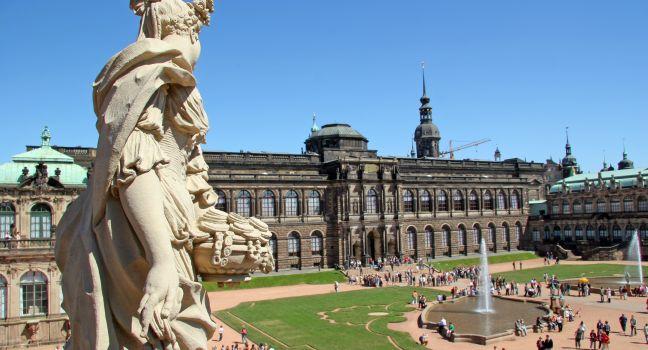Dresden's magnificent Baroque showpiece is entered by way of the mighty Kronentor (Crown Gate), underneath the crown of Poland, off Ostra-Allee. It contains three different museums.
Augustus the Strong hired a small army of artists and artisans to create a "pleasure ground" worthy of the Saxon court on the site of the former bailey, part of the city fortifications. The artisans worked under the direction of the architect Matthäus Daniel Pöppelmann, who came reluctantly out of retirement to design what would be his greatest work, begun in 1707 and completed in 1728. Completely enclosing a central courtyard filled with lawns, pools, and fountains, the complex is made up of six linked pavilions, one of which boasts a carillon of Meissen bells, hence its name: Glockenspielpavillon.
The Zwinger is quite a scene—a riot of garlands, nymphs, and other elaborate ornamentation and sculpture. Wide staircases beckon to galleried walks and to the romantic Nymphenbad, a coyly hidden courtyard where statues of nude women perch in alcoves to protect themselves from a fountain that spits unexpectedly. The Zwinger once had an open view of the riverbank, but the Semper Opera House now occupies that side. Stand in the center of this quiet oasis, where the city's roar is kept at bay by the outer wings of the structure. Normal people were allowed onto the balcony and could watch all of the raucous festivities
The Gemäldegalerie Alte Meister, in the northwestern corner of the complex, was built to house portions of the royal art collections. Among the priceless paintings are works by Dürer, Holbein, Jan Van Eyck, Rembrandt, Rubens, van Dyck, Hals, Vermeer, Raphael, Titian, Giorgione, Veronese, Velázquez, Murillo, Canaletto, and Watteau. On the wall of the entrance archway you'll see an inscription in Russian, one of the few amusing reminders of World War II in Dresden. It rhymes in Russian: "Museum checked. No mines. Chanutin did the checking." Chanutin, presumably, was the Russian soldier responsible for checking one of Germany's greatest art galleries for anything more explosive than a Rubens nude. The highlight of the collection is Raphael's Sistine Madonna, whose mournful look is slightly less famous than the two cherubs who were added by Raphael after the painting was completed, in order to fill an empty space at the bottom.
Stretching from the curved gallery that adjoins the Glockenspielpavillon to the long gallery on the east side, this collection of the Porzellansammlung is considered one of the best of its kind in the world. The focus, naturally, is on Dresden and Meissen china, but there are also outstanding examples of Japanese, Chinese, and Korean porcelain.
Holding medieval and Renaissance suits of armor and weapons, the Rüstkammer also has a branch in the Residenzschloss.




